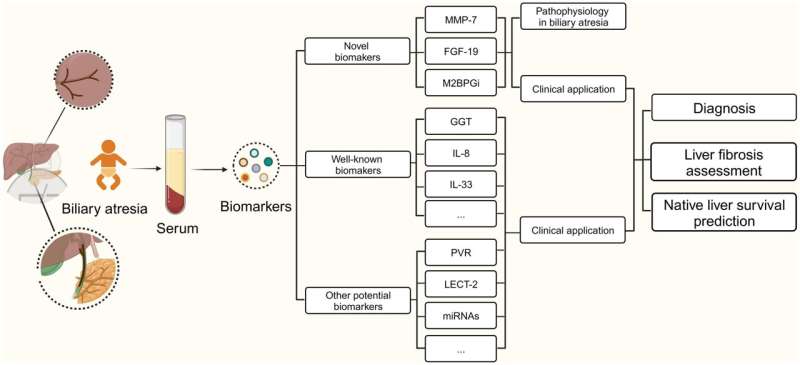This article has been reviewed according to Science X's editorial process and policies. Editors have highlighted the following attributes while ensuring the content's credibility:
fact-checked
proofread
Progress in biomarkers related to biliary atresia

Biliary atresia (BA) is a severe neonatal liver disease characterized by inflammatory and fibrotic obliteration of intrahepatic and extrahepatic bile ducts. This condition often leads to neonatal jaundice, cirrhosis, and portal hypertension, making it the leading cause of pediatric liver transplants.
The etiology of BA is still unclear, but potential factors include viral infections, environmental toxins like biliatresone, immune responses, and genetic predispositions. Early diagnosis and treatment, primarily through Kasai portoenterostomy (KPE), significantly improve outcomes. However, the lack of reliable non-invasive diagnostic methods poses a challenge for early detection and management.
Key biomarkers in biliary atresia:
- Matrix metalloproteinase-7 (MMP-7): MMP-7 is pivotal in the degradation of extracellular matrix proteins, influencing tissue remodeling and fibrosis. Studies have identified elevated levels of MMP-7 in BA patients, suggesting its significant role in BA-associated liver fibrosis. MMP-7 serves as a marker for epithelial injury and has shown potential in early diagnosis and prognosis of BA, particularly in predicting liver fibrosis stages. Elevated serum levels of MMP-7 in BA patients correlate with the extent of bile duct proliferation and fibrosis, making it a valuable non-invasive biomarker for assessing disease severity and guiding treatment decisions.
- Fibroblast growth factor 19 (FGF-19): FGF-19 is involved in bile acid regulation and liver growth. Elevated serum levels of FGF-19 in BA patients indicate its potential as a biomarker for early diagnosis and disease progression assessment. Its role in liver regeneration and bile acid homeostasis makes it a crucial marker for evaluating liver function and predicting post-KPE outcomes. FGF-19's ability to modulate bile acid synthesis and promote hepatocyte proliferation underscores its importance in the pathophysiology of BA and its utility in monitoring disease progression.
- Mac-2 binding protein glycosylation isomer (M2BPGi): M2BPGi has emerged as a novel marker for liver fibrosis. Elevated M2BPGi levels correlate with the severity of liver fibrosis in BA patients, making it a valuable tool for non-invasive fibrosis staging. Its high sensitivity and specificity for liver fibrosis highlight its clinical utility in monitoring disease progression and guiding treatment strategies. M2BPGi's association with extracellular matrix remodeling and fibrogenesis further emphasizes its relevance as a biomarker for BA, providing insights into the dynamic changes in liver pathology.
Established biomarkers
- Gamma-glutamyltransferase (GGT): GGT is a well-established biomarker for liver dysfunction. Elevated GGT levels are commonly observed in BA patients and serve as an indicator of bile duct obstruction and liver damage. GGT's widespread use in clinical practice underscores its reliability in diagnosing and monitoring BA. The enzyme's role in glutathione metabolism and its response to oxidative stress highlight its significance in the context of biliary obstruction and hepatocellular injury in BA patients.
- Circulating cytokines: Inflammatory cytokines play a significant role in BA pathogenesis. Elevated levels of cytokines such as interleukin-6 (IL-6) and tumor necrosis factor-alpha (TNF-α) have been documented in BA patients, reflecting the underlying inflammatory processes. These cytokines can aid in differentiating BA from other neonatal cholestatic diseases and assessing the inflammatory status of the liver. The involvement of cytokines in immune-mediated bile duct injury and fibrosis underscores their potential as therapeutic targets and diagnostic markers in BA.
Advancements in the identification of BA-related biomarkers have significantly enhanced the diagnosis, staging, and prognosis of this challenging disease. MMP-7, FGF-19, and M2BPGi are promising markers that offer non-invasive alternatives for early detection and monitoring of liver fibrosis. Established markers like GGT and circulating cytokines continue to provide valuable insights into disease status and progression.
Ongoing research into these biomarkers holds the potential to improve clinical outcomes and optimize management strategies for BA patients. The integration of these biomarkers into clinical practice can facilitate early diagnosis, guide therapeutic interventions, and improve the overall prognosis for patients with biliary atresia.
The paper is published in the Journal of Clinical and Translational Hepatology.
More information: Fanyang Kong et al, Progress in Biomarkers Related to Biliary Atresia, Journal of Clinical and Translational Hepatology (2024). DOI: 10.14218/JCTH.2023.00260





















